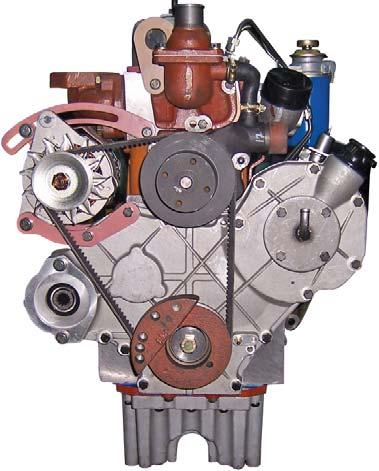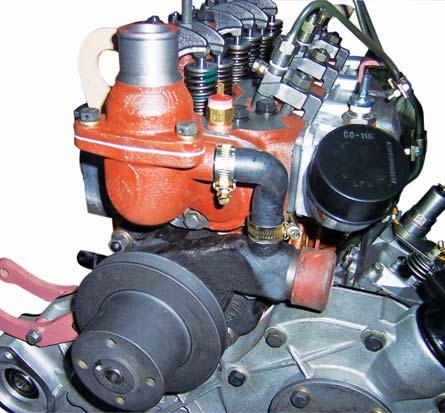
2 minute read
Cooling System
d.Unscrew the generator mounting bolt & nut, loose the nut, bolt of generator adjustment brace. Slide oft the generator belt.
e.Loosen the inlet hose clamp which clamps the hose to the radiator inlet tube and work the hose free from the tube.
f.Disconnect the battery earth lead.
g.Loosen the outlet hose clamp which clamps the hose to the water pump and work the hose free from the pump. Slacken the two hose clips then remove the thermostat by pass hose.
h.Lift the fan housing clear of the tractor.
i.Remove the nut and setscrew which secures the adjustable pulley flange to the pulley hub and unscrew the flange from the hub. Slide off the drive belt.
j.Unscrew the four nuts (1-7) from the water pump mounting studs.
k.Withdraw the water pump as far as possible along the mounting studs and towards the radiator.
7.THERMOSTAT :
The Blocker type Thermostat is located in Thermostat Housing (2-7). The Thermostat controls the Engine operating temperature.
When the Engine is cold the Thermostat is closed, preventing circulation of Coolant until it reaches operating temperature. The thermostat is set to open at 82 OC (180 O F) b.Removal
NOTE: When the Thermostat fails in the open position, the Engine runs too cold. Thereby the Cylinder Sleeves get glazed, leading to excessive consumption of Lubricating Oil. A Cold running Engine is damaged by combustion gas. ‘Blow by’, Crankcase condensation resulting in sludge formation in the Oil, High wear and corrosion of Engine parts and rapid clogging of the positive Crankcase ventilation system.

Do not to remove the Thermostat from Tractors for any reason whatsoever except to replace a defective thermostat.
1.Drain the cooling system.
2.Loosen the clamps on the radiator upper hose and work the hose clear of the thermostat housing.
3.Remove the three capscrews (1-12) from the thermostat housing (2-12) and withdraw the thermostat.
Cooling System
2)INSPECTION
Suspend the thermostat and a thermometer in a pan of water until the thermostat opens. It should begin to open at 82 OC (180 OF) and fully open by 91 OC (196 OF).
(c)Installation
1.Insert the thermostat into its housing with the bellows end downwards and install new gasket.

2.Tighten the capscrews.
3.Work the hose back on to the thermostat housing and tighten the hose clamps securely.
4.Fill the radiator with clean water.
7.HOSES
Top and bottom hoses should be checked at least twice a year for deterioration. The main thing to look for are hardness or conversely, sponginess. In first case, hardness leads to lack of flexibility and cracking; the latter causing leakage and also allows the passage of small particles of rubber into the Radiator, blocking the cores. Sponginess leads to lining failure and eventual rupture of the Hose.
When installing new hoses, particular attention should be paid to the connections. If you want a first class job, the steel pipe connections should be cleaned and non hardening sealing compound used in conjunction with original/good quality Hose Clips always fitted with the Screw Heads in the most convenient position for adjustment with the Screw Driver. All new Hoses and their connection should be checked a couple of times subsequent to fitting. After the Engine has been in use, retighten all connections, as necessary.










